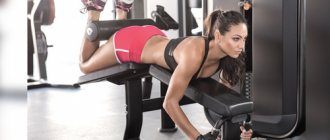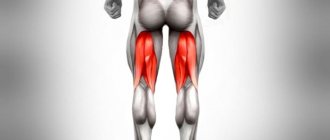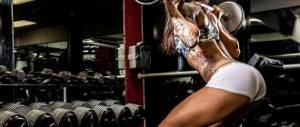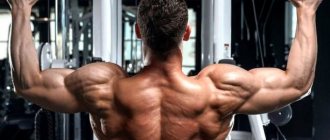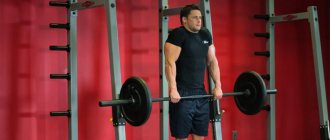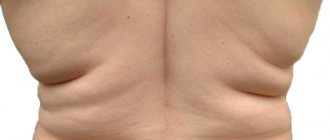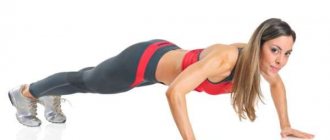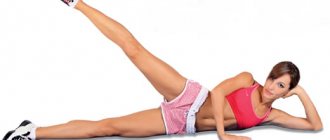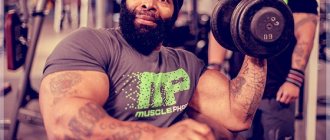Leg abduction machine[edit | edit code]
Leg abduction machine “Glute”
Leg abduction exerciser
or the
“GLUTE”
- a block-type strength simulator for developing the muscles of the buttocks, by alternately moving the legs back with a load in a standing position.
Instructions for use
Components[edit | edit code]
The sports strength training machine is equipped with a locking lever, thanks to which you can take the starting position with maximum convenience. The machine for the gluteal muscles has a footrest that is adjustable with a remote lock. This ensures a comfortable position for an athlete of any height. Installation of exercise machines for training the buttocks in the gym is carried out using holes for fastening to the floor.
Thigh muscles anterior group
It is this group that forms the thigh from the front. For men, the development of these muscles is of paramount importance. Several main muscles can be identified.
Sartorius
The shape resembles a narrow ribbon. And it is the longest muscle in our body. Its upper end originates from the anterior surface of the ilium. Then it descends obliquely down the front surface of the thigh. And is attached to the tuberosity of the tibia.
Functions:
Participates in flexion of the thigh and lower leg. With fixed hips, the pelvis tilts forward. It also participates in turning the hip inward.
Quadriceps femoris (quadriceps)
This is the largest muscle in our body. From the name it is clear that it consists of 4 heads:
Rectus muscle
The largest of the 4 heads. Located centrally on the front of the thigh. It is this muscle that forms the thickness of the leg. It originates from the lower surface of the ilium. Heading down, it passes into the common tendon. Which is attached to the tibial tuberosity.
Functions:
Due to the fact that the muscle crosses two joints: the hip and knee. She can not only straighten her leg at the knee. But also bend it at the hip.
Important:
When leaning forward during squats, this head is less involved in the work.
Vastus medialis
Located on the anteromedial (inner) surface of the lower thigh. From above it is slightly blocked by the rectus muscle. The shape resembles a drop of water. When well developed, it gives the thigh an expressive shape. From above, a thin tendon is attached to the inner side of the femur. Next, its fibers go down and pass into the broad tendon. With them it partially passes into the common tendon. And the remaining fibers are attached to the inner edge of the patella.
Functions:
Leg extension at the knee joint. Turn the shin inward. Stabilizes the knee, preventing it from falling inward.
Vastus lateralis muscle
Located on the outer part of the front surface of the thigh. Occupying almost the entire area. Slightly covered by the rectus muscle. This head gives shape to the thigh from the outside. Making your legs more massive. In bodybuilding, it is given special importance compared to other strength sports. It originates from the outside of the femur. Heading down, it passes into the common tendon of the 4 heads. And in some bundles it is woven into the lateral (outer) edge of the patella.
Functions:
Leg extension at the knee joint. Rotate the shin outward. Acts as a knee stabilizer. Not letting it fall out. That is, it performs the opposite action of the medial head.
Vastus intermedius muscle
Located on the front of the thigh, immediately under the rectus muscle. It is the weakest among all heads. The upper edge is attached to the anterior surface of the femur. And heading down it passes into the common tendon.
Functions:
Participates in leg extension at the knee joint.
Features of the simulator[edit | edit code]
- footrests enable athletes of any size to use this sports equipment to the maximum;
- the convenient design of the supports minimizes the load on the kneecaps;
- to set the starting position it is not necessary to get up from the simulator;
- paired leg rests enable athletes of any size to make the most of this sports equipment;
- Thanks to the non-linear trajectory of movement, only the buttock muscles are involved in the training, while the thigh muscles remain isolated.
Leg muscles
The legs are the largest muscle group of all. But for some reason, most athletes treat their development irresponsibly. Giving preference to the top of your body. Of course, the chest and back are also very important, but without big and strong legs, it will be very difficult to progress in the future. And in terms of aesthetics, which athletes strive for, everything will be very sad. Just imagine what a person with broad shoulders, a massive back and pecs will look like. But at the same time skinny legs. And for girls in general, this muscle group is paramount in their training. It's like constructing buildings. The legs protrude here like a large and strong foundation. Two pillars on which the rest of the structure rests. And if the foundation is not laid properly, then no matter how strong the structure is, it will still collapse.
Technique of working on the simulator[edit | edit code]
The technique is not complicated. Your position is fixed, and stabilizer muscles do not take part in the process. The biggest advantage is that the quadriceps are not involved. You're working your butt, not your hips. For maximum core stability, press tightly against the machine.
- Set the required weight.
- When performing this exercise on buttock exercise machines, rest your other leg on a special platform. Both legs should be slightly bent at the knee joints.
- As you exhale, use a strong force in your leg muscles to push the platform back up.
- You should not straighten your leg too much; you need to move your leg back so that your thigh is almost parallel to the floor.
- We return the leg to its original position slowly.
- Then, after finishing the complex, we change the leg and do the complex for the other leg.
Exercises to train the gluteal muscles
From what was written above, we can notice that these muscles connect the pelvis and thigh. Thus, they become stabilizers for our legs. They also move the leg to the side. But the most important thing is the participation of the gluteus maximus muscle in hip extension. In order to develop them, you need to select exercises where these functions are present. There are several most effective ones:
- Sumo squats.
All conditions are met here. Due to the wide stance of the legs, the leg abduction function is activated. When you come into a standing position from a sitting position, the hip extension occurs. And in order not to lose balance, the stabilizing function of these muscles comes into play. - Romanian deadlift - this exercise is aimed at working the buttocks. And it is one of the best for these purposes. The main function it involves is hip extension. Thus, it actively activates the gluteus maximus muscle. And by bending the legs at the knee joint, the biceps femoris muscle is excluded from the work.
- Leg abduction in crossover.
You can move your leg in different directions. Back, focusing on hip extension and working the gluteus maximus. And to the side, engaging the middle and small muscles.
Thigh muscles posterior group
These muscles are antagonists for the anterior group. That is, they perform opposite functions. The front one extends the leg, and the back one bends it. In their training, the main thing is to exclude the gluteal muscles from the work as much as possible. If we don't do this then they will take on most of the load. This group includes:
Biceps muscle (biceps femoris)
Located along the outer (lateral) edge of the back of the thigh. This muscle is the main one in this group. And most of the exercises are aimed at its development. Consists of two heads:
- Long.
Which starts from the ischial tuberosity, with a small flat tendon. - Short.
It originates from the inner surface of the lower half of the femur.
Below, these two heads unite into one powerful abdomen. Which passes into a narrow tendon. And bending around the back of the lateral epicondyle of the femur, it is attached to the head of the fibula.
Functions:
Extends the thigh together with the gluteal muscle. Bending the leg at the knee joint. And in this position it can turn it outward.
Semitendinosus muscle
This is a long and thin muscle. It is located closer to the inner (medial) edge of the back of the thigh. Starts from the ischial tuberosity. Heading down, it passes into a thin tendon that wraps around the medial epicondyle of the femur from behind. And is attached to the tuberosity of the tibia.
Functions:
Participates in hip extension and leg flexion at the knee joint.
Semimembranosus muscle
Located along the inner edge of the back of the thigh. Covered below by the semitendinosus muscle. It originates from the ischial tuberosity. Heading down, it goes around the epicondyle of the femur and attaches to the medial condyle of the tibia.
Functions:
Extends the hip. Bends his leg. It also turns the shin inward with the knee joint bent.
Hamstring workout
That is, as we see, exercises should perform two main functions. This is hip extension or leg flexion. We can also use foot rotation in some exercises. When bringing your toes together, the semitransverse muscle is loaded more. When extended to the sides, hamstrings.
- Deadlift on straight legs
. This is a basic exercise. Which engages the hip extension function when coming out of a bend. Thus, all the muscles of the posterior group are activated. And since the legs remain straight when tilted. Most of the load will be taken by the back of the thigh. - Squats with wide legs.
Also applies to basic exercises. Involves two functions. Bend the leg at the moment of the squat itself. And hip extension when returning to the starting position. Squats also work all 3 gluteal muscles. And the adductor muscles receive a small share of the load. - Leg bending in the simulator.
Here I think everything is clear. The exercise gives us the opportunity to work the back of the thigh in isolation. By bending the leg at the knee joint. - Taking the leg back in a crossover.
This exercise is mainly performed by girls. It allows you to work all the muscles of the posterior group in isolation.
What you need to know about the gluteal muscles
Before you start training your buttocks in the gym, it is important to know some facts about these muscles:
- the shape of the buttocks cannot be changed;
- You can remove excess fat in the buttocks area only with the help of cardio training;
- you need to exercise regularly;
- It is very important for women to correctly perform butt exercises in the gym so as not to injure themselves and not overwork other muscles, such as the quadriceps.
Calf muscles
These muscles are stabilizers for our feet. And is involved in bending the leg at the knee joint. The muscles of the anterior group are responsible for turning the foot, flexing and extending the fingers. But as I said earlier, we will not consider them. We are more interested in the back group. Which includes:
Triceps surae muscle
This is the main muscle that can be trained, and we can influence its shape.
Consists of two muscles:
Calf
lies on the surface and has two powerful heads.
- Medial. It is located closer to the inner part of the back surface of the lower leg. And it is more powerful. Starts from the posterior surface of the medial epicondyle of the femur.
- Lateral. This head, on the contrary, is located closer to the outer part of the lower leg. And it starts from the posterior surface of the lateral epicondyle of the femur.
These two heads are directed downwards and in the middle of the lower leg they are connected into one powerful tendon. The second muscle is the soleus.
This is a flat muscle. Located under the calf. One edge is attached to the head of the fibula. And the other to the inner surface of the tibia. And going down, it connects to the tendon of the gastrocnemius muscle. Which attaches to the heel bone. This tendon is known to many as the Achilles tendon.
Functions:
Participates in bending the leg at the knee joint. Flexes the foot. It is also a stabilizer for the lower leg muscles.
Plantaris muscle
This is a very short muscle that has a long and thin tendon. It originates from the lateral condyle of the femur. It goes down and passes into a narrow tendon that lies between the soleus and gastrocnemius muscles. Attaches to the heel bone.
Functions:
Helps bend the leg at the knee joint. Participates in raising the foot. Tenses the capsule of the knee joint.
Walking to the side
Place the elastic around your ankles. Stand in a quarter squat (lower squat) with your feet hip-width apart and your hands at chest level or on your hips. Take 2-3 steps to the right with your right foot so that your feet are shoulder-width apart. Then repeat the same on the left side. Do 20 repetitions - 10 times on each leg. During the exercise, try to keep your body straight, without leaning to the side, keep your buttocks tense, and your lower back engaged.
Taking the leg back
Place a resistance band around your ankles. Keeping your hands at chest level or on your hips, transfer your weight to your left leg and take your right leg back about 20-30 cm from the floor, lowering your foot only to the tips of your toes. During the exercise, keep your abs and buttocks tense, keep your back straight, and your knees should be pointing straight. You should feel good resistance in the elastic band. Do the set 20 times, then change legs and repeat the same.
To make the training even more effective, also add leg abduction to the side and diagonally to the back swings. These exercises with elastic bands will help you work out the back of your thighs and tighten your buttocks.
Calf muscle training
Based on what was written above, we can draw a conclusion. That this muscle group receives part of the load in almost any exercise for the legs where we bend them at the knee joint. Plus, they act as a stabilizer for the foot and are also used when rising onto the toes. There are several specialized exercises:
- Calf raises in a special machine.
There are a lot of such simulators. There is an option where we perform the exercise standing, sitting and even lying at an angle. Therefore, choose any exercise machine that is in your gym and start raising your toes. - "Donkey."
Refers to a number of rarely seen exercises in modern gyms. But by bodybuilders of the golden era, it was in demand. By tilting the body forward, we stretch the buttocks and the back of the thigh. Therefore, they will not be able to turn on and take the load from the calf muscles. - Calf raises with dumbbells.
This is similar to the first exercise, but instead of a machine, a dumbbell weight is used. For greater stability, take it in one of the hands and perform lifts on each leg in turn.
Source
Walking at an incline
Place the elastic band around your ankles. Stand with your feet shoulder-width apart. Bend your knees a few centimeters, bend your arms at chest level, and lean your torso forward, as shown in the example. Keep your abs and buttocks tight. Take 10 steps forward and 10 steps back. During the exercise, keep your back straight and your shoulders back.
Get started now! Motivation for losing weight
Squats with leg abduction
Secure the elastic band on your hips, just above your knees. Stand with your feet shoulder-width apart and keep your hands at chest level or on your hips. Bend your knees, push your buttocks back and do a deep squat. Step back and step your right leg out to the side, keeping your knee straight, then lower your leg to the floor. Repeat the squat again, but this time repeat the trick with your left leg. Do 20 reps, alternating both legs.
Raising legs on all fours to the side
Place the elastic band slightly above your knees. Get on all fours, placing your knees hip-width apart and your hands exactly shoulder-width apart. Your knees should be bent at right angles and your hips vertical. Without moving your hips or changing the position of your pelvis, move your left knee to the side, keeping it bent. Slowly return your leg to the starting position. Repeat 20 times and then repeat the same on your right leg.
Exercises to train the front of the thigh
As you already understand, this muscle group extends the leg at the knee joint. The most effective exercises that fit these functions include:
- Front squats .
Due to the fact that the bar is located in front, we will be forced to tilt it back a little. So as not to drop it. Therefore, most of the load will fall on the quadriceps. The main function involved in this exercise is leg extension. - Bench press in a machine with narrow legs.
Due to the narrow setting, the gluteal muscles are not included in the work. To shift the emphasis to the lateral head, place your feet together. On the medial side, place shoulder width apart. - Stepping onto the platform.
In this exercise, we focus on leg extension. And this is the main function of the quadriceps. - Leg extensions in a sitting machine
. It is a very dangerous exercise. Therefore, you should not use it on an ongoing basis. To avoid damaging your knee joints. From the name it is clear that it meets our requirements. Namely, it extends the leg at the knee joint. When we turn our toes to the side, we load the lateral head more. And inside, medial.
On topic: How many times should you pump your legs?
Raising legs on all fours back
Secure the elastic band around your left foot and right ankle as shown above. Get into a pose on all fours with your knees level with your pelvis and your arms extended exactly shoulder-width apart. Raise your left leg up, bent at the knee. Hold it in this position for 2 seconds (longer if you can), and then return it to the starting position. Continue this 20 times, then change legs and repeat again.

